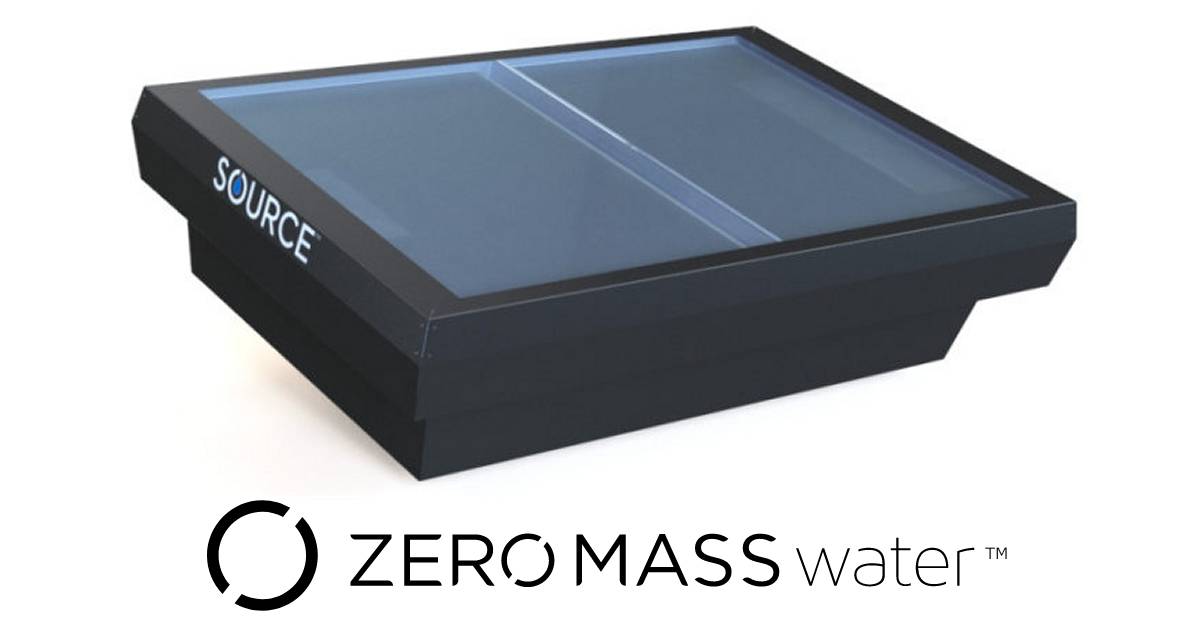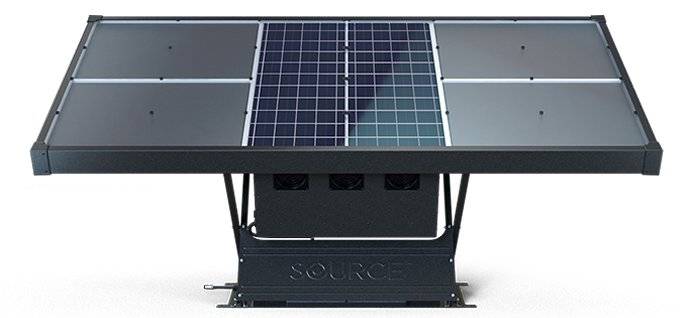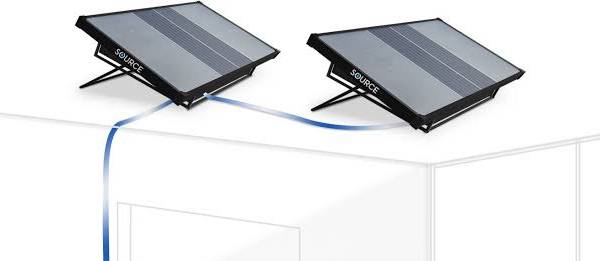
Image: Zero Mass Water via VentureBeat
The company commercially producing a solar powered device that extracts drinking water from air will be showcasing the new Source Rexi hydropanel at CES in Las Vegas this week.
We first mentioned Zero Mass Water’s Source hydropanel back in 2017 – the original model looked like this:
Recent versions are more streamlined:
How The Source Hydropanel Works
The Source hydropanel first absorbs water vapor from the air with a hygroscopic material. Using energy generated by the solar panels that is stored in a small battery, the water vapor respires from the materials inside, raising the relative humidity to a passively condensing vapor that is collected. The collected water passes through a mineralising cartridge in the reservoir, then passes through an activated carbon polishing cartridge before being dispensed at the tap. The system is mesh networked and monitored by Zero Mass Water for the purposes of monitoring and troubleshooting.
A standard array consisting of two Source hydropanels can produce between 4 – 10 litres of clean water a day depending on humidity levels and other conditions.
Zero Mass Water says since 2017, Source hydropanels have been installed in more than 35 countries on 6 continents. Among the countries is Australia, where Zero Mass scored $420,000 in funding from the Australian Renewable Energy Agency in 2018 to support the deployment 150 systems across multiple locations.
New Model – Source Rexi Hydropanel
VentureBeat reports Zero Mass Water will be showing off a new model (picture at the beginning of this article), the Source Rexi Hydropanel, at CES in Las Vegas this week.
According to the VentureBeat article, the Source Rexi Hydropanel is half the size of the previous model, easier to install and is able to extract more water on a daily basis – how much more isn’t mentioned.
But where have the solar panels gone – are they now separate? Perhaps it doesn’t include them at all, working instead with an existing solar installation and/or mains supply.
Apparently, the new model will be suitable for the rooftops of homes.
We’ll update this post as further details on the Source Rexi hydropanel become available.
Cost And Water-As-A-Service Model
Source hydropanels are still very expensive – a standard array consists of 2 hydropanels at a total cost of between USD $5,500 and $6,500 including shipping, installation and tax in the USA for the current model – so around AUD $7,900 – $9,400 at current exchange rates. It looks like pricing of the Source Rexi Hydropanel will be around the same as the current model assuming two are used.
In addition to the initial outlay are costs associated with replacing the mineralising cartridge every 5 years, the polishing cartridge annually and the battery at some point/s. The system has an expected service life of 15 years before requiring a major service that will likely involve the replacement of some components.
The cost of the Source Rexi Hydropanel solution and output needs to be weighed up against the cost of bottled or otherwise packaged/transported water – so whether financially it makes sense depends on the location and situation where it will be used. From an environmental viewpoint, the system can avoid waste from bottled/packaged water. However, water bottles can generally be recycled and the “recyclability” of the Source system isn’t clear.
Zero Mass is also offering a water-as-a-service model under a Water Purchase Agreement (WPA) arrangement; but this appears to only be available for larger installations. An example of this model in Australia is in Queensland, where water created by a Source hydropanel array extracting up to 1 million litres annually is being sold under contract to Waddi Springs.



 RSS - Posts
RSS - Posts



Glad to hear they have a mineralization cartridge. Gotta have some minerals inside you and you can run low drinking distilled or demineralized water.
I’ve been in contact with the Australian distributors (HydroPoint) as we were going to put two of them on our house at the end of January. The current models are $4,299 each AUD each and $8,598 for two. Then there’s $700 installation ($1,400 x 2) so $9,998 for full installation. And they offer finance. Ben Bowie at HydroPoint has been great with info and keeping me informed on the product.
It’s a bit of a hike up from when they were first on sale through Bing Lee and were $3,800 each but a business has to make a healthy profit to be viable in the longer term.
After reading today about the new version I’m going to put off installing them until I get water tanks and roof top sprinklers installed. Not much point installing them if the house has been burnt to the ground hey?
Dont do it. They are unreliable at best. I have owned for past 4 years. Out of my 5 panels, 2 at any one time work, the others are always broken with service backup terrible ( 2 visits in 4 years). Once they sell the panels they just dont care. DONT DO IT.
I fail to see the point ,,,,,,,,,$8,000 plus for 10 litres of water/day when the United Nations says 15Litres per person/day.
At Disaster Aid Australia we install water filters that treat 10,000 litres per day without using power for $5,000 with 10 years before the membrane needs replacing. Enough for 700 people ( http://www.disasteraidaustralia.org.au/our-aid/skyhydrant/)
But for the Skyhydrant you need a source of water for it to purify, right? I’m guessing this is aimed for areas that are completely dry.
But who is going to pay $8000 to just get 10litres? To get enough for cooking and washing you are going to need 30-40 Litres a day per person so that’s going to be $24,000 per person.
The market for people paying that sort of money for that little water, so they can live in a desert, must be tiny.
The driest location in Australia receives an average of 125mm of rain a year. That’s 125 litres per square meter. The air is extremely dry there, but if a water-from-air system produces 4 litres a day its annual output will be equal to a water tank with 12 square meters of catchment. That’s an area of about 3.5m by 3.5m. Clearly, the price will have to fall a long way for it to be more than a toy. But at $9.99 per unit we could irrigate deserts with them.
UPDATE: No, that’s 12.5 litres per square meter requiring a catchment area of 120 square meters, which is 11m by 11m. I made a stupid mistake and was off by an order of magnitude. The air capture device is looking a lot better now, although it’s still going to find it hard to compete with rainwater capture at its current price.
Your math was right the first time. One litre is 1000 cubic centimetres, equal to one millimeter spread over 1 square metre (100×100×0.1 = 1000cc)
You may want to look at Multigensolutions.com.au for a solar driven Air Water Generator making 15,30 and 60 Litres a day.
http://www.multigensolutions.com.au
How well do your membranes last with very hard alkalai mineral loaded bore water?
Might come in handy if there is a WWIII
Save the money, spend it on wells or piping instead. Or for tanks to store water when it falls from the sky.aa How much water is in the air in the desert? The clue is in the word “desert”. Can’t break the laws of thermodynamics folks. It’s just a dehumidifier. Available at all appliance shops, along with solar panels for a fraction of the cost. $8000 would pay for about 30 hand pump wells serving about 400 people in Bangladesh. Disappointing the Australian government doesn’t know basic science and wastes money in this crap.